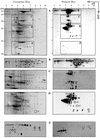Genome-based bioinformatic selection of chromosomal Bacillus anthracis putative vaccine candidates coupled with proteomic identification of surface-associated antigens
- PMID: 12874336
- PMCID: PMC165985
- DOI: 10.1128/IAI.71.8.4563-4579.2003
Genome-based bioinformatic selection of chromosomal Bacillus anthracis putative vaccine candidates coupled with proteomic identification of surface-associated antigens
Abstract
Bacillus anthracis (Ames strain) chromosome-derived open reading frames (ORFs), predicted to code for surface exposed or virulence related proteins, were selected as B. anthracis-specific vaccine candidates by a multistep computational screen of the entire draft chromosome sequence (February 2001 version, 460 contigs, The Institute for Genomic Research, Rockville, Md.). The selection procedure combined preliminary annotation (sequence similarity searches and domain assignments), prediction of cellular localization, taxonomical and functional screen and additional filtering criteria (size, number of paralogs). The reductive strategy, combined with manual curation, resulted in selection of 240 candidate ORFs encoding proteins with putative known function, as well as 280 proteins of unknown function. Proteomic analysis of two-dimensional gels of a B. anthracis membrane fraction, verified the expression of some gene products. Matrix-assisted laser desorption ionization-time-of-flight mass spectrometry analyses allowed identification of 38 spots cross-reacting with sera from B. anthracis immunized animals. These spots were found to represent eight in vivo immunogens, comprising of EA1, Sap, and 6 proteins whose expression and immunogenicity was not reported before. Five of these 8 immunogens were preselected by the bioinformatic analysis (EA1, Sap, 2 novel SLH proteins and peroxiredoxin/AhpC), as vaccine candidates. This study demonstrates that a combination of the bioinformatic and proteomic strategies may be useful in promoting the development of next generation anthrax vaccine.
Figures


Similar articles
-
Search for Bacillus anthracis potential vaccine candidates by a functional genomic-serologic screen.Infect Immun. 2006 Jul;74(7):3987-4001. doi: 10.1128/IAI.00174-06. Infect Immun. 2006. PMID: 16790772 Free PMC article.
-
In vitro screen of bioinformatically selected Bacillus anthracis vaccine candidates by coupled transcription, translation, and immunoprecipitation analysis.Methods Mol Biol. 2007;375:211-33. doi: 10.1007/978-1-59745-388-2_11. Methods Mol Biol. 2007. PMID: 17634604 Review.
-
Search for potential vaccine candidate open reading frames in the Bacillus anthracis virulence plasmid pXO1: in silico and in vitro screening.Infect Immun. 2002 Dec;70(12):6817-27. doi: 10.1128/IAI.70.12.6817-6827.2002. Infect Immun. 2002. PMID: 12438358 Free PMC article.
-
Identification of chromosomally encoded membranal polypeptides of Bacillus anthracis by a proteomic analysis: prevalence of proteins containing S-layer homology domains.Proteomics. 2004 Mar;4(3):677-91. doi: 10.1002/pmic.200300575. Proteomics. 2004. PMID: 14997491
-
Bacillus anthracis genetics and virulence gene regulation.Curr Top Microbiol Immunol. 2002;271:143-64. doi: 10.1007/978-3-662-05767-4_7. Curr Top Microbiol Immunol. 2002. PMID: 12224521 Review.
Cited by
-
Secretome, surfome and immunome: emerging approaches for the discovery of new vaccine candidates against bacterial infections.World J Microbiol Biotechnol. 2016 Sep;32(9):155. doi: 10.1007/s11274-016-2107-3. Epub 2016 Jul 27. World J Microbiol Biotechnol. 2016. PMID: 27465855 Review.
-
Cytosolic proteins contribute to surface plasminogen recruitment of Neisseria meningitidis.J Bacteriol. 2007 Apr;189(8):3246-55. doi: 10.1128/JB.01966-06. Epub 2007 Feb 16. J Bacteriol. 2007. PMID: 17307854 Free PMC article.
-
Comparative Analysis of the Global Transcriptomic Response to Oxidative Stress of Bacillus anthracis htrA-Disrupted and Parental Wild Type Strains.Microorganisms. 2020 Nov 30;8(12):1896. doi: 10.3390/microorganisms8121896. Microorganisms. 2020. PMID: 33265965 Free PMC article.
-
Identification of candidates for a subunit vaccine against extraintestinal pathogenic Escherichia coli.Infect Immun. 2007 Apr;75(4):1916-25. doi: 10.1128/IAI.01269-06. Epub 2006 Dec 4. Infect Immun. 2007. PMID: 17145948 Free PMC article.
-
Identification of a second collagen-like glycoprotein produced by Bacillus anthracis and demonstration of associated spore-specific sugars.J Bacteriol. 2005 Jul;187(13):4592-7. doi: 10.1128/JB.187.13.4592-4597.2005. J Bacteriol. 2005. PMID: 15968070 Free PMC article.
References
-
- Ahmed, S., S. Meghji, R. J. Williams, B. Henderson, J. H. Brock, and S. P. Nair. 2001. Staphylococcus aureus fibronectin binding proteins are essential for internalization by osteoblasts but do not account for differences in intracellular levels of bacteria. Infect. Immun. 69:2872-2877. - PMC - PubMed
-
- Altschul, S. F., W. Gish, W. Miller, E. W. Myers, and D. J. Lipman. 1990. Basic local alignment search tool. J. Mol. Biol. 215:403-410. - PubMed
-
- Altschul, S. F., and E. V. Koonin. 1998. Iterated profile searches with PSI-BLAST—a tool for discovery in protein databases. Trends Biochem. Sci. 23:444-447. - PubMed
MeSH terms
Substances
LinkOut - more resources
Full Text Sources
Other Literature Sources
Medical
Molecular Biology Databases
Miscellaneous

